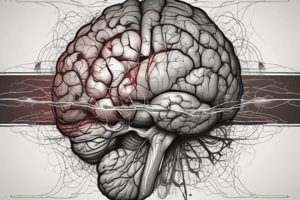Podcast
Questions and Answers
What is the recommended oxygen flow rate for a patient with head trauma who is unstable?
What is the recommended oxygen flow rate for a patient with head trauma who is unstable?
- 6 liters/minute
- 15 liters/minute with a non-rebreathing mask (correct)
- 10 liters/minute
- 20 liters/minute
What is the initial step in the special considerations of head trauma patients?
What is the initial step in the special considerations of head trauma patients?
- Assist respiration’s as needed
- Assess Glasgow Coma Scale (correct)
- Assume neck injuries in all patients and immobilize if indicated
- Dress scalp hemorrhage with pressure dressing
When should code 3 transport be carried out for a head trauma victim?
When should code 3 transport be carried out for a head trauma victim?
- If in shock, treat according to shock protocol
- If scalp hemorrhage can be life threatening
- In any head trauma victim with deteriorating neuro status, shock, or markedly abnormal neurological status (correct)
- If airway problems occur while immobilized
What should be done if airway problems occur while a head trauma patient is immobilized?
What should be done if airway problems occur while a head trauma patient is immobilized?
What is the recommended oxygen flow rate for a patient with chest trauma who is in respiratory distress?
What is the recommended oxygen flow rate for a patient with chest trauma who is in respiratory distress?
What should be done if signs of tension pneumothorax develop in a patient with chest trauma?
What should be done if signs of tension pneumothorax develop in a patient with chest trauma?
What is the recommended treatment for open chest wounds in patients with chest trauma?
What is the recommended treatment for open chest wounds in patients with chest trauma?
What should be done if a patient with chest trauma develops flail chest?
What should be done if a patient with chest trauma develops flail chest?
What actions should be taken if a patient with chest trauma has impaled objects?
What actions should be taken if a patient with chest trauma has impaled objects?
What is the recommended treatment for a clavicle fracture?
What is the recommended treatment for a clavicle fracture?
What action should be taken for a patient with a scapula fracture?
What action should be taken for a patient with a scapula fracture?
How should a pelvis fracture be managed according to the orthopedic trauma treatment protocol?
How should a pelvis fracture be managed according to the orthopedic trauma treatment protocol?
What is the appropriate treatment for an elbow dislocation?
What is the appropriate treatment for an elbow dislocation?
How should a shoulder fracture or dislocation be splinted according to the orthopedic trauma treatment protocol?
How should a shoulder fracture or dislocation be splinted according to the orthopedic trauma treatment protocol?
What is the recommended treatment for foot fracture (ankle) according to the Basic Life Support (BLS) Protocols?
What is the recommended treatment for foot fracture (ankle) according to the Basic Life Support (BLS) Protocols?
What is the initial step in the special considerations for splinting unstable fractures with no pulses, according to the BLS Protocols?
What is the initial step in the special considerations for splinting unstable fractures with no pulses, according to the BLS Protocols?
What should be done if a patient with hip fracture and dislocation is encountered according to the BLS Protocols?
What should be done if a patient with hip fracture and dislocation is encountered according to the BLS Protocols?
What is the recommended action for treating traumatic amputations according to the BLS Protocols?
What is the recommended action for treating traumatic amputations according to the BLS Protocols?
According to the BLS Protocols, what should be done for jaw (maxillo-facial trauma) patients?
According to the BLS Protocols, what should be done for jaw (maxillo-facial trauma) patients?
What is the first step to stop life-threatening bleeding from an arm or leg if a tourniquet is available, according to the given text?
What is the first step to stop life-threatening bleeding from an arm or leg if a tourniquet is available, according to the given text?
What should be done for life-threatening bleeding from the neck, shoulder, or groin if a tourniquet is NOT available, according to the given text?
What should be done for life-threatening bleeding from the neck, shoulder, or groin if a tourniquet is NOT available, according to the given text?
When should the distal neurovascular status be checked as per the given text?
When should the distal neurovascular status be checked as per the given text?
What should be applied around the bleeding arm or leg about 2 to 3 inches above the bleeding site if a tourniquet is available, according to the given text?
What should be applied around the bleeding arm or leg about 2 to 3 inches above the bleeding site if a tourniquet is available, according to the given text?
What should be done if life-threatening bleeding occurs from an arm or leg and a tourniquet is NOT available OR for bleeding from the neck, shoulder, or groin, according to the given text?
What should be done if life-threatening bleeding occurs from an arm or leg and a tourniquet is NOT available OR for bleeding from the neck, shoulder, or groin, according to the given text?
Flashcards
Head Trauma Oxygen Flow Rate
Head Trauma Oxygen Flow Rate
15 liters/minute with a non-rebreathing mask for unstable patients.
Initial Head Trauma Assessment
Initial Head Trauma Assessment
Assess the Glasgow Coma Scale.
Code 3 Transport for Head Trauma
Code 3 Transport for Head Trauma
For deteriorating neuro status, shock, or abnormal neurological status.
Airway Problems During Immobilization (Head Trauma)
Airway Problems During Immobilization (Head Trauma)
Signup and view all the flashcards
Chest Trauma Oxygen Flow Rate
Chest Trauma Oxygen Flow Rate
Signup and view all the flashcards
Tension Pneumothorax Treatment
Tension Pneumothorax Treatment
Signup and view all the flashcards
Open Chest Wound Treatment
Open Chest Wound Treatment
Signup and view all the flashcards
Flail Chest Treatment
Flail Chest Treatment
Signup and view all the flashcards
Impaled Object in Chest Trauma
Impaled Object in Chest Trauma
Signup and view all the flashcards
Clavicle Fracture Treatment
Clavicle Fracture Treatment
Signup and view all the flashcards
Scapula Fracture Action
Scapula Fracture Action
Signup and view all the flashcards
Pelvis Fracture Splinting
Pelvis Fracture Splinting
Signup and view all the flashcards
Elbow Dislocation Treatment
Elbow Dislocation Treatment
Signup and view all the flashcards
Shoulder Fracture/Dislocation Splinting
Shoulder Fracture/Dislocation Splinting
Signup and view all the flashcards
Foot/Ankle Fracture Splinting
Foot/Ankle Fracture Splinting
Signup and view all the flashcards
Splinting Unstable Fractures (No Pulse)
Splinting Unstable Fractures (No Pulse)
Signup and view all the flashcards
Hip Fracture/Dislocation Stabilization
Hip Fracture/Dislocation Stabilization
Signup and view all the flashcards
Traumatic Amputation Treatment
Traumatic Amputation Treatment
Signup and view all the flashcards
Jaw Trauma (Maxillo-facial)
Jaw Trauma (Maxillo-facial)
Signup and view all the flashcards
Stopping Arm/Leg Bleeding (Tourniquet)
Stopping Arm/Leg Bleeding (Tourniquet)
Signup and view all the flashcards
Controlling Neck/Shoulder/Groin Bleeding (No Tourniquet)
Controlling Neck/Shoulder/Groin Bleeding (No Tourniquet)
Signup and view all the flashcards
Neurovascular Status Checks
Neurovascular Status Checks
Signup and view all the flashcards
Treating Shock with Limb Bleeding
Treating Shock with Limb Bleeding
Signup and view all the flashcards
Life-Threatening Limb Bleeding (No Tourniquet)
Life-Threatening Limb Bleeding (No Tourniquet)
Signup and view all the flashcards




